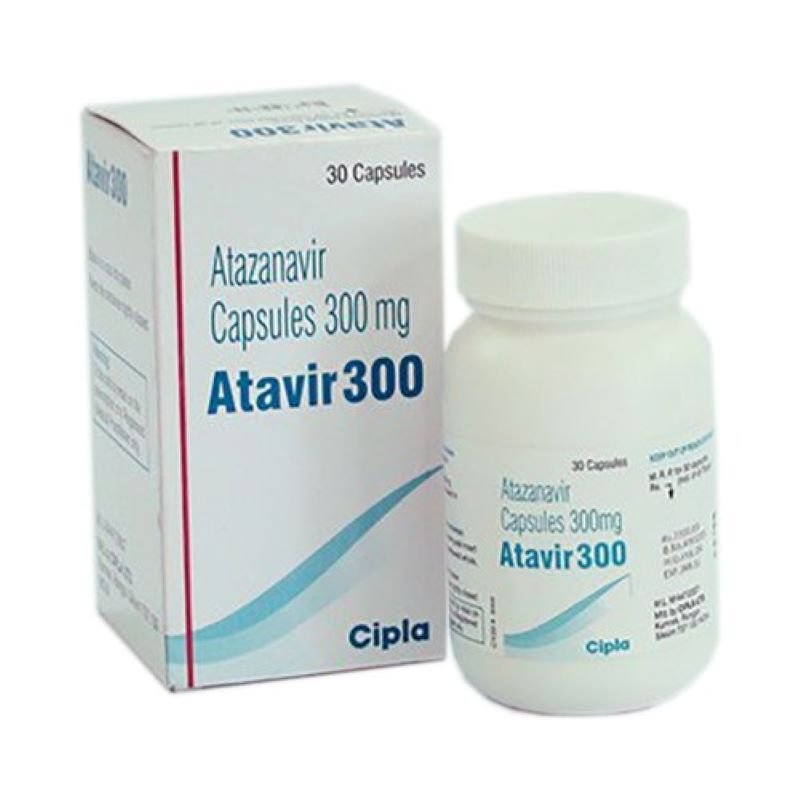Atavir 300 mg (Atazanavir)
$80 – $205Price range: $80 through $205
| Active Ingredient (Generic Name) | Atazanavir |
|---|---|
| Indication | HIV infection |
| Manufacturer | Cipla Ltd |
| Packaging | 30 Capsules in 1 Bottle |
| Pack Size | 30 Capsules, 60 Capsules, 90 Capsules |
| Delivery Time | 6 to 15 days |
| Atavir 300 mg (Atazanavir) | |||
|---|---|---|---|
| Pack Size | Price | Per Unit | Qty |
| 30 Capsules | $80 | $2.67 | |
| 60 Capsules | $150 | $2.50 | |
| 90 Capsules | $205 | $2.28 | |
Introduction
If you or someone you know is managing a medical condition that requires specific medication, you might have come across the term “Atavir 300 (Atazanavir).” In this article, we’ll delve into the details of Atavir 300, exploring its uses, benefits, and potential side effects. Whether you’re a patient, a healthcare professional, or simply curious about pharmaceutical advancements, this guide aims to provide valuable insights to enhance your understanding of this medication.
Table of Contents
ToggleAtavir 300 (Atazanavir): What is it?
Atavir 300, also known by its generic name Atazanavir, is an antiretroviral medication used in the treatment of human immunodeficiency virus (HIV) infections. It falls under the category of protease inhibitors, which work by blocking certain viral enzymes, slowing down the replication of the virus, and reducing the viral load in the body.
The Mechanism of Action
When HIV infects the body, it replicates and spreads by using certain enzymes, including protease. Atavir 300 inhibits the protease enzyme, preventing the virus from maturing and releasing new infectious particles. This action significantly reduces the viral load, which is essential for managing HIV and delaying disease progression.
Uses of Atavir 300 mg (Atazanavir)
Atavir 300 plays a crucial role in the management of HIV infections. Its primary uses include:
Treatment of HIV: Atazanavir 300 is prescribed in combination with other antiretroviral medications to control HIV infections and improve the patient’s quality of life.
HIV Prophylaxis: In certain situations, Atazanavir 300 mg may be used as post-exposure prophylaxis (PEP) to prevent HIV transmission after potential exposure, such as needlestick injuries or unprotected sexual encounters.
Preventing Mother-to-Child Transmission: Pregnant women with HIV may receive Atavir 300 as part of a comprehensive antiretroviral regimen to reduce the risk of transmitting the virus to their unborn child.
Dosage and Administration
The appropriate dosage of Atavir 300 varies depending on factors such as the patient’s age, weight, renal function, and other medications they are taking. It’s crucial to follow the prescribed dosage and administration instructions provided by a qualified healthcare professional.
Typically, Atavir 300 is taken once daily with food, as this enhances its absorption and effectiveness. Patients should avoid crushing or chewing the medication, as it may alter the drug’s release mechanism.
Potential Side Effects
Like any medication, Atavir 300 may cause side effects in some individuals.
Common side effects include:
Gastrointestinal Issues: Nausea, vomiting, and diarrhea are among the most common side effects. Incorporating food intake while consuming the medication may aid in alleviating these symptoms.
Hyperbilirubinemia: Atavir 300 can cause elevated levels of bilirubin, a yellow pigment in the blood, which might lead to jaundice. However, this side effect is generally harmless.
Rash or Skin Reactions: Some individuals may experience skin rashes or other allergic reactions. If any severe skin reactions occur, medical attention should be sought immediately.
Metabolic Effects: Atavir 300 may lead to changes in lipid levels, including cholesterol and triglycerides. Regular monitoring and lifestyle adjustments can help manage these effects.
Interactions with Other Medications
Before starting Atavir 300, it’s crucial to inform your healthcare provider about all the medications and supplements you are currently taking. Atavir 300 can interact with other drugs, potentially affecting their effectiveness or increasing the risk of side effects.
FAQs
1: Can Atavir 300 be used alone to treat HIV?
No, Atavir 300 should never be used as monotherapy to treat HIV. It is always prescribed in combination with other antiretroviral medications to ensure effective viral suppression and reduce the risk of drug resistance.
2: Is Atavir 300 safe to use during pregnancy?
Atavir 300 may be used during pregnancy when the benefits outweigh the potential risks. Pregnant women living with HIV should work closely with their healthcare providers to develop a comprehensive antiretroviral regimen that considers both the mother’s health and the prevention of mother-to-child transmission.
3: Can I drink alcohol while taking Atavir 300?
It’s best to avoid alcohol while taking Atavir 300. Alcohol consumption can interfere with the metabolism of the medication and may lead to increased side effects or reduced effectiveness.
4: What should I do if I miss a dose of Atazanavir 300 mg?
If you miss a dose of Atavir 300, take it as soon as you remember, unless it’s almost time for the next scheduled dose. If such a situation arises, it is advisable to forgo the missed dose and adhere to the usual dosing timetable. Avoid taking double doses to make up for the missed one.
5: Are there any dietary restrictions while taking Atavir 300?
Atavir 300 is best taken with food to enhance its absorption and minimize gastrointestinal side effects. However, there are no specific dietary restrictions associated with the medication.
6: Can Atazanavir 300 cure HIV?
Atazanavir 300 is not a cure for HIV. It is an antiretroviral medication that helps manage the virus and slow down disease progression. A cure for HIV has not yet been discovered, but with the appropriate antiretroviral therapy, the virus can be effectively controlled.
Conclusion
Atavir 300 (Atazanavir) is a valuable antiretroviral medication used in the management of HIV infections. Its mechanism of action uses, and potential side effects have been explored in this guide to provide readers with a comprehensive understanding of the drug. Always remember to follow the prescribed dosage and consult with a healthcare professional for personalized advice and recommendations.













